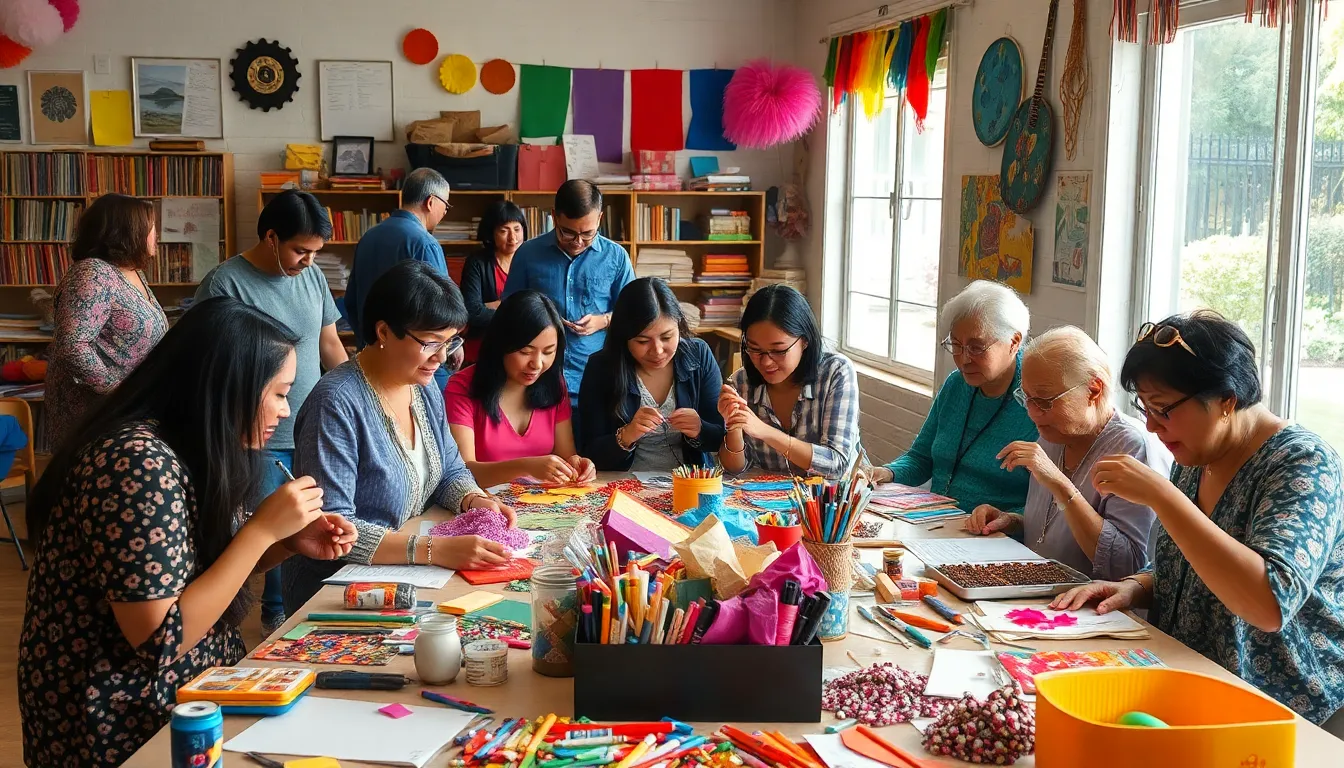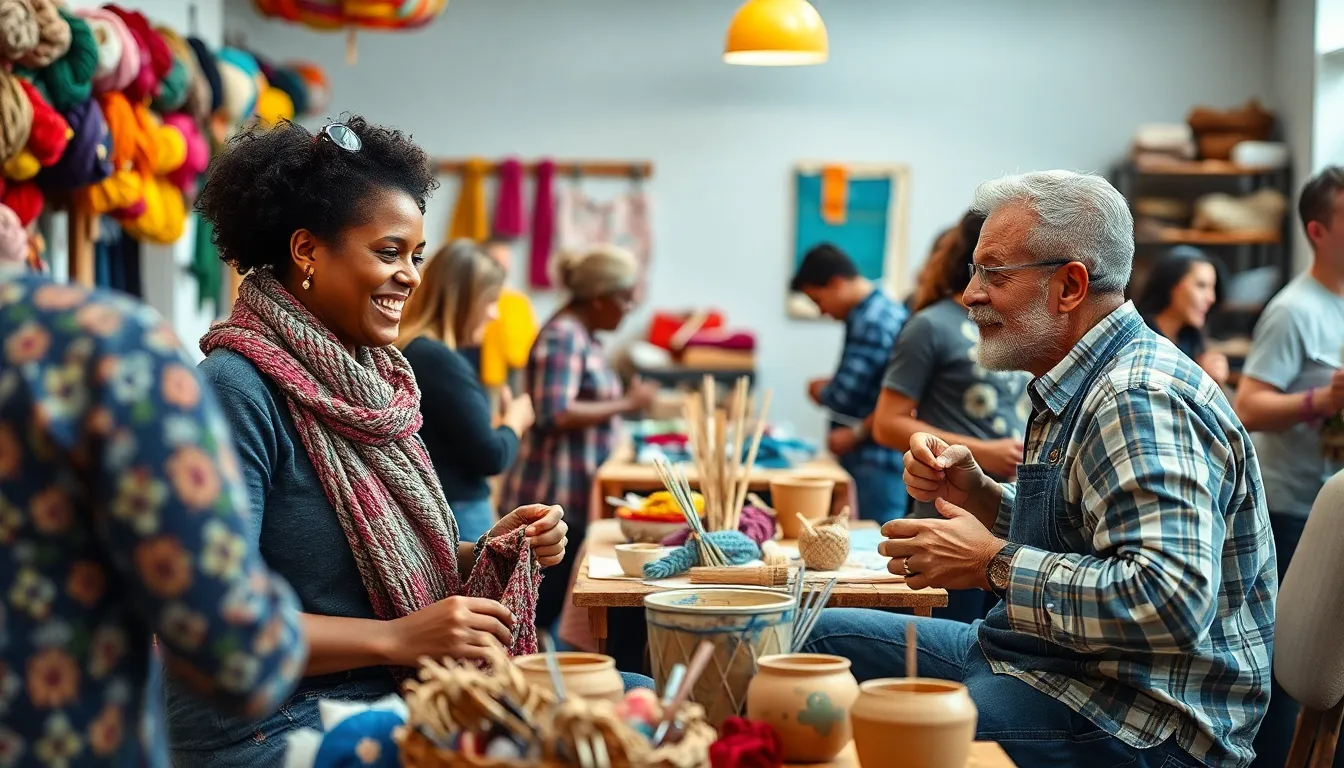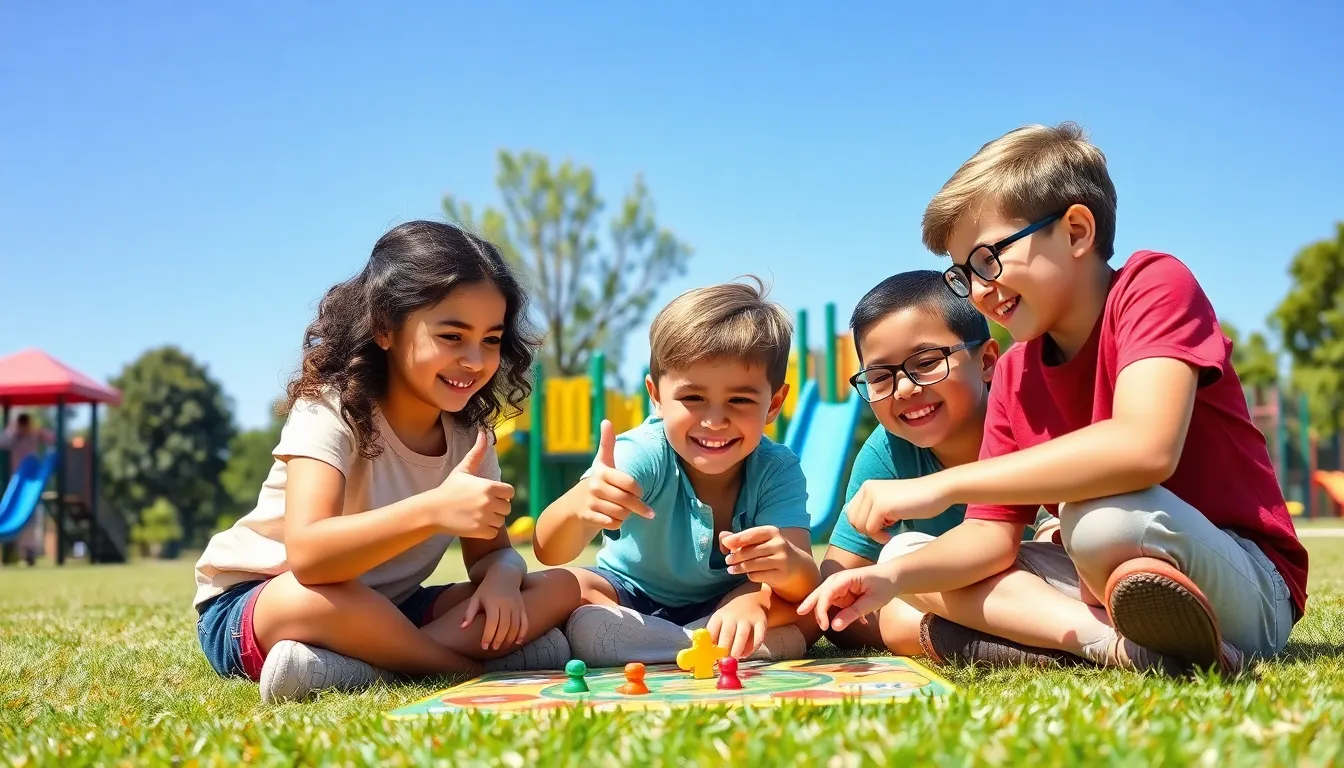In a world where social media can feel more like a lonely scroll through endless cat videos, crafting communities are the vibrant oasis everyone needs. Imagine a space where creativity flourishes and friendships bloom over shared passions—whether it’s knitting cozy sweaters or building intricate model trains. These communities offer a warm hug of support and inspiration, making even the most novice crafter feel like a Picasso with a glue gun.
Crafting isn’t just about the finished product; it’s about the journey and the people you meet along the way. From local meet-ups to online forums, these communities are the secret sauce that turns solitary hobbies into collaborative masterpieces. So grab your glue, gather your yarn, and let’s dive into the colorful world of crafting communities that are just waiting to welcome new members with open arms (and maybe a few glittery crafts).
Table of Contents
ToggleOverview of Crafting Communities
Crafting communities serve as essential hubs for creativity and social interaction. These communities bring together individuals who share passions for various crafting techniques, including knitting, quilting, and pottery. Here, members engage in discussions, exchange ideas, and provide support to one another.
Online platforms facilitate these gatherings, allowing people from different backgrounds to connect. Forums, social media groups, and dedicated websites showcase projects, share tutorials, and highlight resources. This accessibility enhances collaboration and inspires creativity, encouraging members to explore new crafting techniques.
Local crafting groups also thrive, fostering face-to-face connections. Many communities organize workshops and meetups that allow crafters to learn from one another. Participants gain hands-on experience, deepen their skills, and create lasting friendships through shared activities.
Crafters often report increased motivation as they collaborate with others. These interactions cultivate a sense of belonging, making crafting a shared experience rather than a solitary pursuit. Individuals express pride in their work, often showcasing completed projects within their community.
Support extends beyond crafting expertise; emotional encouragement plays a key role as well. Members celebrate each other’s successes, offering praise and constructive feedback. This positive reinforcement strengthens bonds and nurtures personal growth within the crafting journey.
In essence, crafting communities embody creativity and connection. They transform hobbies into meaningful experiences, encouraging participation and collaboration. By actively engaging in these groups, individuals contribute to a vibrant culture that enriches their lives and inspires further creativity.
Types of Crafting Communities

Crafting communities come in various forms, each offering unique opportunities for connection and creativity. Two prominent types include online crafting communities and local crafting groups.
Online Crafting Communities
Online crafting communities thrive on digital platforms. Members engage through social media groups and specialized forums focused on diverse crafts. These communities provide instant access to resources, tutorials, and peer support. Participants share images and ideas, fostering inspiration and collaboration among crafters worldwide. They can also form friendships across distances, making crafting a global experience. The multitude of platforms ensures crafters find their niche, whether in knitting, scrapbooking, or digital design.
Local Crafting Groups
Local crafting groups serve as gathering spaces for face-to-face interaction. Individuals connect through workshops, classes, and meetups that promote collaboration and skill-sharing. These groups often establish a strong sense of community, creating enriching friendships based on similar interests. Crafters can collaborate on projects and participate in local events, enhancing their crafting journey. Many groups also organize charity events, allowing members to contribute to the community while improving their skills. The personal interactions within these groups foster deeper connections and support systems.
Benefits of Participating in Crafting Communities
Participating in crafting communities brings numerous advantages. Members experience personal growth, creativity, and enhanced social interactions.
Skill Development
Skill development remains a primary benefit of crafting communities. Members share techniques, tips, and resources, fostering a rich learning environment. Experienced crafters often mentor beginners, offering guidance on complex projects. Workshops hosted by local groups provide hands-on experience, allowing participants to explore new crafting methods. Online platforms also feature tutorials and videos that enhance learning opportunities. Regular practice and collaboration with others encourage skill refinement. Engaging with various crafting styles exposes members to diverse approaches, enriching their overall capabilities.
Social Interaction
Social interaction thrives within crafting communities. Crafting serves as a catalyst for building friendships based on shared interests. Members connect through discussions, sharing project ideas, and celebrating achievements. Online forums allow for instant support, creating a sense of belonging among participants. Local groups host meetups that foster deeper connections among members, encouraging camaraderie. Many crafting events promote collaboration, allowing crafters to work together on projects. Emotional support becomes a vital aspect of these interactions, as members celebrate successes and offer encouragement during challenges. Shared experiences contribute to a collective spirit, enhancing the overall crafting journey.
Challenges Faced by Crafting Communities
Crafting communities encounter several challenges that can hinder their growth and effectiveness.
Inclusivity Issues
Inclusivity remains a significant barrier for many crafting communities. A lack of representation among members can lead to feelings of isolation for individuals from diverse backgrounds. New participants may feel unwelcome if community norms aren’t welcoming or inclusive. Crafting groups often struggle to bridge the gap between experienced crafters and novices, making it essential to create a supportive environment. Addressing these inclusivity issues fosters a sense of belonging, allowing all crafters to thrive and contribute their unique perspectives.
Resource Limitations
Resource limitations pose challenges for crafting communities, impacting both availability and accessibility. Many groups rely on donations or limited budgets, restricting their ability to host workshops and events. Beginners may struggle to find materials or tools necessary for participation. Moreover, online platforms can generate significant traffic but lack sufficient funding for maintenance or growth. Increasing access to resources ensures that all community members can engage fully, benefiting from shared knowledge and collaboration.
Future Trends in Crafting Communities
Emerging technologies shape the future of crafting communities significantly. The rise of virtual reality (VR) and augmented reality (AR) enhances immersive experiences, allowing crafters to participate in workshops from anywhere. This technology fosters interactive learning, bridging gaps for those unable to attend local groups.
Sustainability trends also influence crafting communities. More crafters prioritize eco-friendly materials and practices, leading to groups focused on upcycling and using natural resources. Sustainability reinforces community values and attracts environmentally conscious members, ensuring longevity.
Diverse crafting techniques arise from globalization. Crafters worldwide share culture-inspired methods, enriching the creativity landscape. This trend emphasizes collaboration among global practitioners, fostering a sense of unity through shared experiences.
Social media’s role in crafting communities continues to grow. Platforms like TikTok and Instagram facilitate instant sharing of projects and tutorials, creating vibrant networks of inspiration. Engagement metrics indicate increased interaction and connectivity among members, enhancing the sense of belonging.
Inclusivity remains a critical focus. Crafting communities increasingly recognize the importance of diverse representation. By creating welcoming spaces, groups can address feelings of isolation, drawing in underrepresented individuals.
Micro-communities develop within larger groups, promoting specialized interests. These focus areas allow members to connect with others who share niche passions, fostering strong ties and dedicated collaboration. As crafting continues to evolve, these trends will shape how individuals interact and grow within their communities.
Crafting communities offer a unique blend of creativity and connection that enriches the lives of their members. These vibrant spaces foster collaboration and support, transforming individual hobbies into shared experiences. By embracing inclusivity and addressing resource challenges, these communities can thrive and welcome diverse voices.
As technology continues to evolve, crafting communities will adapt and expand, incorporating new methods of engagement and sustainability. The future looks bright for crafters seeking connection and inspiration. Joining a crafting community not only nurtures personal growth but also strengthens bonds that can last a lifetime. Embracing this journey opens doors to creativity and friendship, making it an invaluable experience for anyone passionate about crafting.




